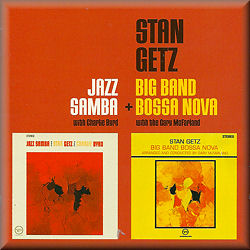1. Desafinado
2. Samba Dees Days
3. O Pato (The Duck)
4. Samba Triste
5. Samba De Uma Nota Só (One Note Samba)
6. É Luxo Só
7. Baia
8. Manha De Carnaval
9. Balanco No Samba (Street Dance)
10. Melancólico
11. Entre Amigos (Sympathy Between Friends)
12. Chega De Saudade (No More Blues)
13. Noite Triste (Night Sadness)
14. Samba De Uma Nota Só (One Note Samba)
15. Bim Bom
16. Desafinado (Single Edited Version)
17. Theme From “Dr. Kildare”
Stan Getz - Tenor sax, with:
Tracks 1-7 & 16: Jazz Samba
Charlie Byrd - Guitar
Gene Byrd - Guitar, bass
Keter Betts - Bass
Buddy Deppenschmidt - Drums
Bill Reichenbach - Percussion
Tracks 8-15: Big Band Bossa Nova
Tracks 12-15: Gary McFarland and His Orchestra
Doc Severinsen, Bernie Glow - Trumpets
Clark Terry - Flugelhorn
Bob Brookmeyer - Valve trombone
Tony Studd - Bass trombone
Ray Alonge - French horn
Ray Beckenstein, Arthur "Babe" Clarke - Clarinets
Jerry Sanfino - Flute
Eddie Caine - Alto flute
Romeo Penque - Bass clarinet
Hank Jones - Piano
Jim Hall - Guitar
Tommy Williams - Bass
Johnny Rae - Drums
Carmen Costa - Cabassa
Jose Paulo - Tambourine
Gary McFarland - Arranger, conductor
Tracks 8-11: Same as above, except Joe Ferrante & Nick Travis - trumpets replace Glow & Terry
Willie Dennis - Trombone replaces Brookmeyer
Walt Levinsky - Clarinet replaces Jerry Sanfino
Ray Beckenstein plays flute
Track 17 Bonus track: Stan Getz - Tenor sax with unidentified orchestra
Even though it wasn't the first bossa nova LP released in the USA,
Jazz Samba was the album which started the craze for this
type of music. It was recorded in 1962, the year after Charlie Byrd's
trio (completed by Keter Betts and Buddy Deppenschmidt) visited Brazil
and were very impressed by the music they heard there. Composers like
Antonio Carlos Jobim and Joao Gilberto had created a gentle version
of the samba which was, indeed, a bossa nova - a new thing.
An edited version of the first track - Desafinado - was a
big hit and one can understand why. It is hypnotic, with the stereotypical
bossa rhythm beaten out on a cowbell, while Getz weaves a warm and
smooth theme statement - and later a gliding solo. Charlie Byrd adds
an appropriate solo, which was deleted from the release as a single.
Byrd's acoustic guitar adds considerably to the tranquil mood of this
track and all the others. This is one of only two Jobim compositions
on the album (co-written with Newton Mendonça), the other being One
Note Samba, which includes a heavenly solo by Getz.
Desafinado and One Note Samba have both become jazz
standards, but I am surprised that Samba Dees Days is not
equally popular. It is a very catchy tune written by Charlie Byrd.
On this album it provides an opportunity for some animated playing
by Getz and Byrd. O Pato (The Duck) is almost as attractive,
while Samba Triste is a moody piece. É Luxo Só seems
to fascinate Getz, who fashions apparently never-ending strings of
extemporization. The LP ended with Baia, which includes some
neat counterpoint between saxophone and guitar. Some reissues of the
LP included the edited version of Desafinado, the tune which
was most responsible for the bossa nova craze.
That craze led to numerous bossa nova albums being recorded by other
jazz musicians, from Quincy Jones to Dave Brubeck. The success of
Jazz Samba led producer Creed Taylor to feature Stan Getz
in another LP six months later. Big Band Bossa Nova used
Gary McFarland's arrangements as a background for Getz's lyrical tenor.
The usual heavy sound of a big band might be regarded as alien to
the gentle pulse of bossa nova, but McFarland's arrangements seldom
swamp the tenor sax but provide a comfortable cushion for Getz to
float on.
That LP began with a sure-fire opener: Manha De Carnaval,
which Luiz Bonfa wrote for the film Black Orpheus. Balanco
No Samba is sprightly, and Entre Amigos has an attractive
melody. Chega De Saudade often featured in Dizzy Gillespie's
repertoire and here there is some nice interplay between the tenor
sax and Bob Brookmeyer's trombone. The trouble with a whole album
of bossa novas is that it can become wearisomely samey, with the restrained
rhythm excluding much excitement. But Stan Getz's angelic playing
makes this whole album listenable.
As a bonus, this CD includes the Theme From "Dr Kildare",
which was originally the A-side of a single on which Desafinado
was the B-side: an arrangement which was swiftly reversed when Desafinado
became a hit. More than 50 years after they were recorded, these tracks
prove that Stan Getz was an ideal exponent of the bossa nova, especially
with his silky, unruffled tone backed by Charlie Byrd's gentle acoustic
guitar.
Tony Augarde
www.augardebooks.co.uk
